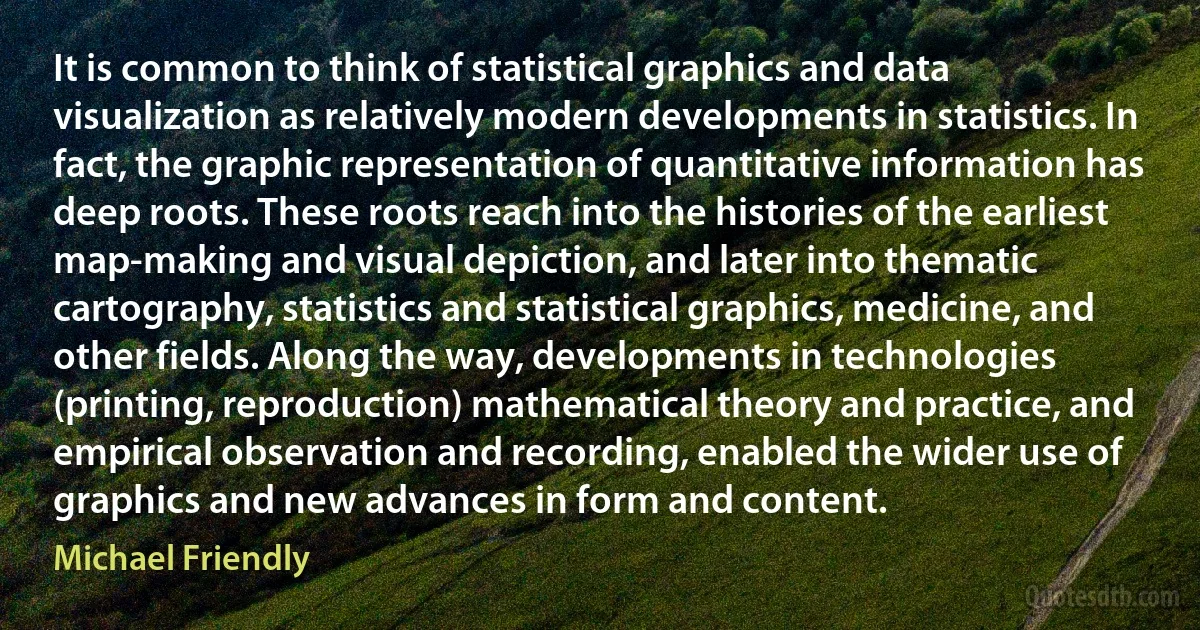
It is common to think of statistical graphics and data visualization as relatively modern developments in statistics. In fact, the graphic representation of quantitative information has deep roots. These roots reach into the histories of the earliest map-making and visual depiction, and later into thematic cartography, statistics and statistical graphics, medicine, and other fields. Along the way, developments in technologies (printing, reproduction) mathematical theory and practice, and empirical observation and recording, enabled the wider use of graphics and new advances in form and content.
Michael FriendlyRelated topics
cartography common content datum deep depiction early form graphic graphics later medicine practice printing reach recording representation reproduction statistics thematic think use visual way visualization fields rootsRelated quotes
The notion that truths external to the mind may be known by intuition or consciousness, independently of observation and experience, is, I am persuaded, in these times, the great intellectual support of false doctrines and bad institutions. By the aid of this theory, every inveterate belief and every intense feeling, of which the origin is not remembered, is enabled to dispense with the obligation of justifying itself by reason, and is erected into its own all-sufficient voucher and justification. There never was such an instrument devised for consecrating all deep-seated prejudices.

John Stuart Mill
A common habit of thought... is the idea that space is [a] simple receptacle in which bodies move around, with no two bodies present at the same point. ...In modern quantum physics generally, and in the standard model of fundamental physics in particular, physical space appears as a far more flexible framework. Many kinds of particles can be present at the same point in space at the same time. Indeed, the primary ingredients of the standard model are not particles at all, but an abundance of quantum fields, each a complex object in itself, and all omnipresent.

Frank Wilczek
The research questions that motivate most quantitative studies in the health, social and behavioral sciences are not statistical but causal in nature. For example, what is the efficacy of a given drug in a given population? Whether data can prove an employer guilty of hiring discrimination? What fraction of past crimes could have been avoided by a given policy? What was the cause of death of a given individual, in a specific incident? These are causal questions because they require some knowledge of the data-generating process; they cannot be computed from the data alone.

Judea Pearl
At a very early stage I realised that it's a real problem to perform electronic music on stage because electronic instruments are not particularly convincing on a visual point of view: somebody behind his computer, it's not particularly visual. So I was inspired by the opera. And what was the opera in the 19th century? It was the idea for a musician to join and to work, to collaborate with a stage director, with carpenters, painters, people doing decors, graphic artists to have a visual prolongation, a visual correspondence to their work. That's what I tried to do with the tools of my generation: electronics and video and lights and all that.

Jean-Michel Jarre
We are living in a period in which many people have changed their mind about what the use of music is or could be for them. Something that doesn't speak or talk like a human being, that doesn't know its definition in the dictionary or its theory in the schools, that expresses itself simply by the fact of its vibrations. People paying attention to vibratory activity, not in reaction to a fixed ideal performance, but each time attentively to how it happens to be this time, not necessarily two times the same. A music that transports the listener to the moment where he is.

John Cage
